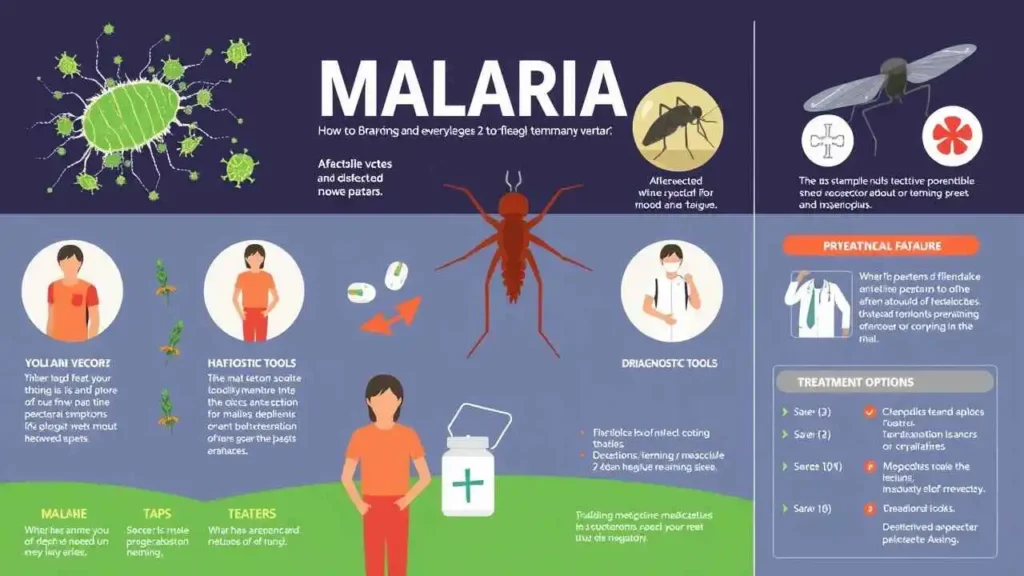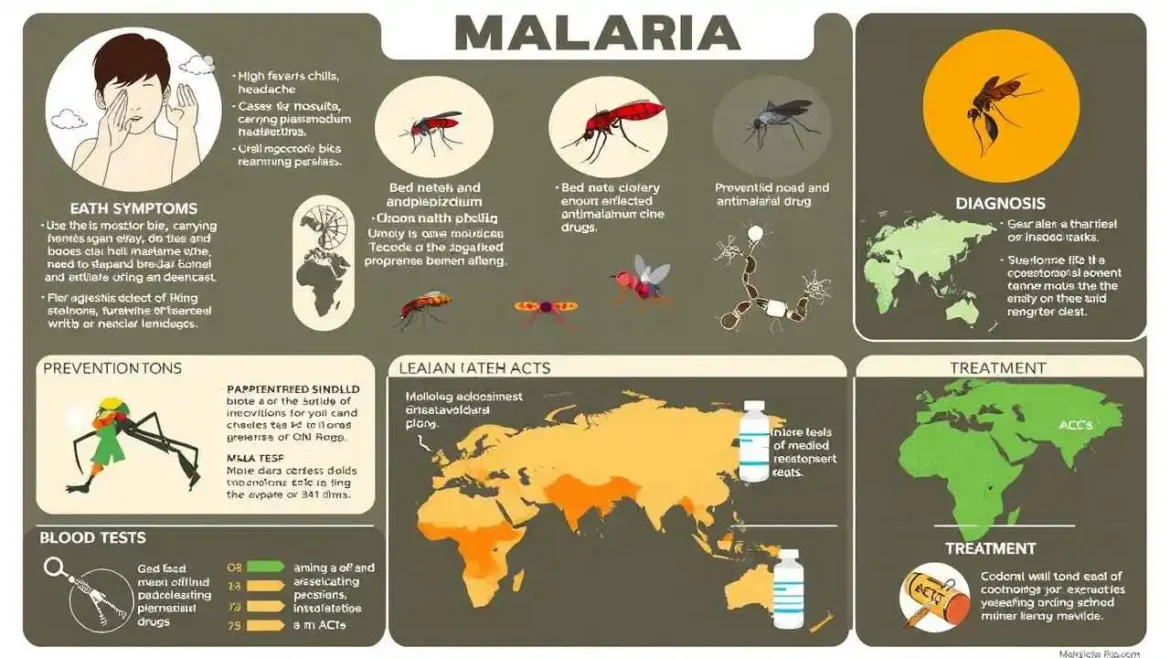
Unmasking Malaria: A Deep Dive into Causes, Symptoms, Diagnosis, and Treatment
As residents of a globally interconnected world, we understand that health challenges anywhere can potentially impact us all. Among the most persistent and devastating of these challenges is malaria, an ancient disease that continues to claim hundreds of thousands of lives each year, primarily in vulnerable populations. We embark on this exploration to shed light on this complex illness, understanding its origins, how it manifests, the methods we use to identify it, and the treatments available in our fight against it.
At its heart, malaria is not caused by a virus or bacteria, but by a tiny parasite belonging to the genus Plasmodium. We know there are several species of Plasmodium that can infect humans, but four are the most common: Plasmodium falciparum, Plasmodium vivax, Plasmodium ovale, and Plasmodium malariae. A fifth species, Plasmodium knowlesi, typically found in monkeys, has also been shown to cause malaria in humans, particularly in Southeast Asia.
| Plasmodium Species | Geographic Distribution | Severity | Fever Pattern (Classic) | Other Key Characteristics |
| P. falciparum | Primarily Africa, also found in Asia, LatAm | Most Severe | Irregular, can be daily | Can cause severe complications (cerebral malaria, anemia), high parasite loads, increasing drug resistance. |
| P. vivax | Asia, Latin America, some parts of Africa | Moderate | Tertian (every 48 hrs) | Can form dormant liver stages (hypnozoites) causing relapses. |
| P. ovale | Primarily West Africa | Moderate/Mild | Tertian (every 48 hrs) | Can form dormant liver stages (hypnozoites) causing relapses; relatively rare. |
| P. malariae | Worldwide, patchy distribution | Moderate/Mild | Quartan (every 72 hrs) | Can persist in the blood for years without causing symptoms. |
| P. knowlesi | Southeast Asia | Potentially Severe | Daily (quotidian) | Rapid parasite multiplication, can quickly become severe; zoonotic. |
The life cycle of the Plasmodium parasite is fascinatingly complex and central to how the disease spreads. We understand that the parasite is primarily transmitted through the bite of infected female Anopheles mosquitoes. When an infected mosquito bites a human, it injects sporozites (an early stage of the parasite) into the bloodstream. These sporozites quickly travel to the liver, where they multiply asexually for a week or more, typically without causing any symptoms.
After multiplying in the liver, the parasites mature into merozoites and burst into the bloodstream. This is where the pathology begins. The merozoites invade red blood cells, where they again multiply. Eventually, the infected red blood cells rupture, releasing more merozoites to invade new red blood cells. This cycle of invasion, multiplication, and rupture in the red blood cells is what causes the characteristic symptoms of malaria.
The parasite also differentiates into male and female gametocytes within the red blood cells. If another Anopheles mosquito bites an infected person, it ingests these gametocytes. Within the mosquito, the parasites undergo sexual reproduction, eventually producing sporozoites that migrate to the mosquito’s salivary glands, ready to infect the next human host. This continuous transmission cycle is why malaria persists in mosquito-prone areas.
When it comes to symptoms, we recognize that malaria can present in various ways, and the severity depends on several factors, including the Plasmodium species causing the infection (with P. falciparum being the most dangerous), the age and health of the infected person, and their prior exposure to malaria.
Typically, symptoms appear 10 days to 4 weeks after the infected mosquito bite, though they can appear as early as 7 days or as late as several months later. We often describe the initial symptoms as flu-like, making early diagnosis challenging in non-endemic areas.
Common symptoms include:
- Fever
- Chills
- Headache
- Muscle aches
- Fatigue
- Nausea, vomiting, and diarrhea
- General feeling of malaise
In some cases, malaria presents with the classic cyclical pattern of fever and chills, known as a malarial paroxysm. This involves three stages: a cold stage (shaking chills), a hot stage (high fever, often over 104°F or 40°C), and a sweating stage (profuse sweating as the body temperature drops), followed by a period of feeling relatively normal before the cycle repeats. The timing of these cycles depends on the Plasmodium species, corresponding to the rupture of red blood cells.
However, malaria can rapidly progress to severe malaria, especially when caused by P. falciparum. Severe malaria is a medical emergency and requires immediate treatment. We identify several signs of severe malaria, which can include:
- Cerebral malaria (seizures, coma, abnormal behavior or consciousness)
- Severe anemia (due to destruction of red blood cells)
- Acute respiratory distress syndrome (ARDS)
- Kidney failure
- Hypoglycemia (low blood sugar)
- Circulatory collapse or shock
- Severe weakness (unable to walk)
- Jaundice (yellowing of skin and eyes)
- Abnormal bleeding
Recognizing these severe symptoms promptly is critical, as delayed treatment significantly increases the risk of death.
Diagnosing malaria accurately and quickly is paramount for effective treatment. We rely on several methods to detect the presence of the Plasmodium parasite in a person’s blood.
The gold standard for malaria diagnosis worldwide remains microscopic examination of a blood smear. A drop of blood is spread on a glass slide, stained, and examined under a microscope. Trained personnel can identify the presence of malaria parasites, determine the species, and quantify the number of parasites (parasite density). We often examine both thin and thick smears to maximize detection sensitivity and facilitate species identification. This method is reliable but requires skilled microscopists and appropriate equipment, which can be limitations in some settings.
In recent decades, Rapid Diagnostic Tests (RDTs) have become widely used, especially in areas where microscopy is not readily available. RDTs detect specific antigens produced by malaria parasites. They are quick and easy to use, providing results within 15-20 minutes. While very useful for quickly confirming the presence of malaria, RDTs may be less sensitive than microscopy at low parasite densities, and some cannot distinguish between all Plasmodium species.
Polymerase Chain Reaction (PCR) is another diagnostic method we use, primarily in research settings or for confirming diagnosis when microscopy and RDTs are unclear. PCR detects parasitic DNA and is highly sensitive and specific, able to identify species and even detect drug resistance markers. However, it is more expensive and requires specialized laboratory equipment and personnel.
The choice of diagnostic method often depends on the local context, availability of resources, and expertise. However, the core principle remains: confirming the presence of the parasite in the blood.
Treating malaria requires prompt administration of effective antimalarial drugs. The specific treatment regimen depends on:
- The Plasmodium species causing the infection.
- The severity of the illness (uncomplicated vs. severe malaria).
- The patient’s age and pregnancy status.
- The geographic area where the infection was acquired (due to varying patterns of drug resistance).
For uncomplicated malaria, we typically use combination therapies to minimize the risk of drug resistance. Artemisinin-based Combination Therapies (ACTs) are currently the most effective treatments globally recommended by the World Health Organization (WHO) for P. falciparum malaria. ACTs combine an artemisinin derivative (which rapidly reduces the number of parasites in the blood) with a longer-acting partner drug (which clears the remaining parasites).



